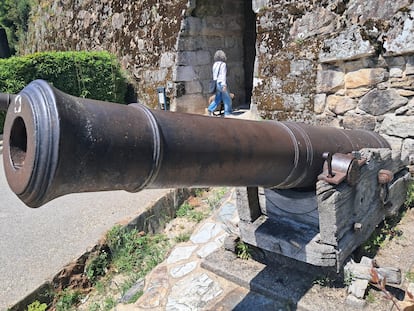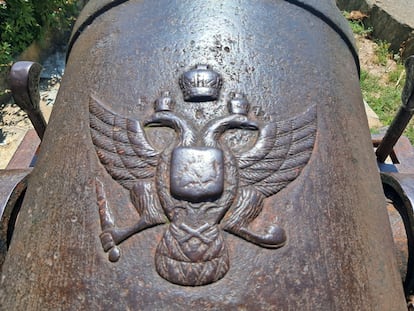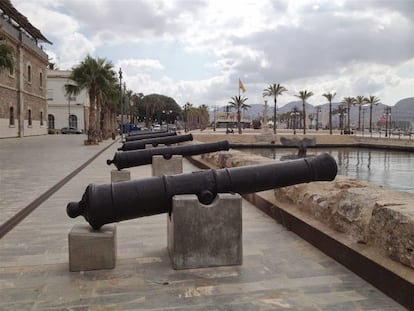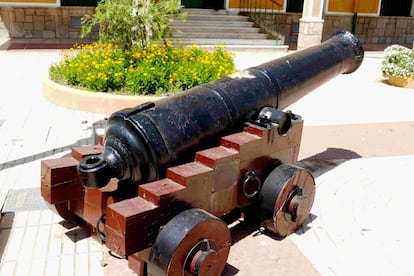The Russian cannons that guard the Spanish coast
The cities of Vigo, Cádiz, Ferrol and Cartagena share artillery that was sent to Spain 200 years ago by Tsar Alexander I in one of the greatest scams in history

The guide provided by the City Council has summoned visitors to the shadow of the gate of a walled enclosure. It crowns O Castro Hill, one of the largest urban parks in Vigo, Spain. But before entering the fortress that, for centuries, served to defend the strategic square from foreign sieges, the historian asks the tourists to dare to leave the coolness of the entrance for a moment. By doing so, they can observe two cannons that are heating up in the spring sun.
“Look at the coat of arms they bear,” she points out. “Do you know where it’s from? [Well], we’re investigating the history of these pieces of artillery. We Vigo residents have seen them all our lives… and it turns out that they’re not from here. They bear the double-headed eagle of the Russian Empire!”
One of the biggest scams in the history of the Spanish monarchy ended up littering the coast, from Cartagena to Ferrol, with arms that were cast in Russia for Tsar Alexander I. The Vigo cannons — mounted on rickety British gun carriages, now without wheels (and awaiting restoration) — are aimed directly at a fountain in a roundabout… and at the people sipping vermouth on the terrace of the O Castro Café.
According to the calculations of a scholar on the subject — naval officer Diego Quevedo Carmona, who has authored a dozen books (the latest of which is available in the Naval Museum of Cartagena) — 630 of these artillery pieces arrived in Spain, but they were never put to proper use.

While at least 18 of them decorate military arsenals, naval museums, public gardens, or places of interest in the cities of Vigo, Cádiz, Ferrol, or Cartagena, many were possibly “reused as material” to reinforce the foundations of Navy buildings (under which cannons have indeed been found). Others were also supposedly recycled as bollards, or used as mooring points on the docks of southeastern Spain. Among the bollards, the researcher from Cartagena (a passionate tracker of historical artifacts and a writer specializing in biographies of Spanish naval officers) has counted up to “15 partially-buried cannons.” But the part protruding from the cement — used to tie mooring ropes — isn’t enough to verify whether the two-headed Tsarist eagle still appears on these old weapons.
The reason why there are so many Russian cannons in Spain is because of an extremely bad deal that Ferdinand VII made with Alexander I, at a time when the Spanish Crown urgently needed ships to hold on to the colonial domains that were slipping away from its grasp.

“Spain had lost a large fleet of warships in the Battle of Trafalgar (1805),” the retired military officer recalls. “Building a ship took a very long time,” hence it was decided to buy them “secondhand” in order to protect Spain’s “overseas possessions.” King Ferdinand VII sought advice from his advisors and decided to initially acquire eight ships from the tsar. The agreement was signed on August 11, 1817, for 68 million reales.
The pine ships from the Baltic, under the command of Rear Admiral Anton Vasilevich Von Moller, began their voyage from Tallinn (the current capital of Estonia) in October of 1817, but didn’t arrive in Cádiz until February 21 of the following year. Over the course of four months, the crew had required long stops to make “multiple” repairs.
Upon arriving in Spain, the Russian part of the scam was uncovered: the ships were almost all in very poor condition, with moth-eaten masts and decks. “They’re known as the ‘Black Ships,’” the O Castro guide tells the tourists. That was a characteristic color of their hulls, but they had also been covered “in tar to stay afloat.” They were cracked, with leaks appearing everywhere. After inspection at the port, most of them were deemed unsalvageable. Only the ironwork could be used.

Ferdinand VII complained to Alexander I. The tsar admitted to the disaster. In compensation, Quevedo notes, he gave away three more frigates, which arrived from Russia in October of 1818. Amid the fiasco, several officials — who had nothing to do with the disastrous business deal promoted by shadowy advisors — were dismissed. Some of the units, Quevedo recounts, “were left in a heap from the first day” in the Bay of Cádiz, considered to be useless and impossible to recover. Each ship was armed with between 36 and 76 cannons.
Two of these vessels later managed to cross the ocean, but bad luck befell them as well: the one renamed Reina Isabel (after Queen Isabella I of Castile) was captured in Chile by the independence fighters, while the Viva was sunk in Havana. The one renamed Alejandro I took on water while crossing the Atlantic and had to return to Spain. The timbers of the Russian ships withstood the cold of the Baltic, but were unsuitable for long voyages through warmer waters. The fleet sold to Spain by Russia was “a real wreck,” the Cartagena researcher concludes.
The resounding botched job also had much to do with the corruption that was rampant within the House of Bourbon, connected in its dealings with the Russian ambassador to Spain. As a fairly informed tourist mentions during the visit to O Castro, it was eventually revealed that money was lost in the payment for the ships. It supposedly vanished among the corridors and curtains of the palace, pocketed by some advisors.
Russia ultimately received little more than half of what was stipulated in the contract and unsuccessfully claimed the rest of the payment for a decade. The purchase transaction had been negotiated by close confidants of the monarch behind the backs of the minister of state and those responsible for the Navy and the Treasury.

Most of the so-called “Black Ships” — with their poor, moth-eaten pine wood — were scrapped between 1821 and 1823. Only a few supplies and the artillery, which now eternally points toward the horizon from ports and gardens, were reusable. Some of these cannons were mounted on Spanish ships named Guerrero, Constitución, Soberano, or Héroe, but they remained forever tattooed at the top of their gun barrels with the two-headed Russian imperial eagle. It wears three crowns, while the creature is draped with a scepter, an orb and a shield that depicts Saint George slaying a dragon.
Sign up for our weekly newsletter to get more English-language news coverage from EL PAÍS USA Edition
Tu suscripción se está usando en otro dispositivo
¿Quieres añadir otro usuario a tu suscripción?
Si continúas leyendo en este dispositivo, no se podrá leer en el otro.
FlechaTu suscripción se está usando en otro dispositivo y solo puedes acceder a EL PAÍS desde un dispositivo a la vez.
Si quieres compartir tu cuenta, cambia tu suscripción a la modalidad Premium, así podrás añadir otro usuario. Cada uno accederá con su propia cuenta de email, lo que os permitirá personalizar vuestra experiencia en EL PAÍS.
¿Tienes una suscripción de empresa? Accede aquí para contratar más cuentas.
En el caso de no saber quién está usando tu cuenta, te recomendamos cambiar tu contraseña aquí.
Si decides continuar compartiendo tu cuenta, este mensaje se mostrará en tu dispositivo y en el de la otra persona que está usando tu cuenta de forma indefinida, afectando a tu experiencia de lectura. Puedes consultar aquí los términos y condiciones de la suscripción digital.
More information
Archived In
Últimas noticias
Maduro pleads not guilty before the federal court in New York: ‘I am still the president of Venezuela’
A new test can detect Alzheimer’s from a finger prick
UN team enters Sudanese city of El Fasher after paramilitary massacre: ‘It’s like a ghost town’
A recipe for resistance: Indigenous peoples politicize their struggles from the kitchen
Most viewed
- Gilles Lipovetsky: ‘If you want to live better and fall in love, take Prozac, don’t look to philosophy’
- Alain Aspect, Nobel laureate in physics: ‘Einstein was so smart that he would have had to recognize quantum entanglement’
- Maduro’s downfall puts China’s relationship with Venezuela to the test
- Why oil has been at the center of Venezuela-US conflicts for decades
- Alvin Hellerstein, a 92-year-old judge appointed by Bill Clinton, to preside over Maduro’s trial in New York










































